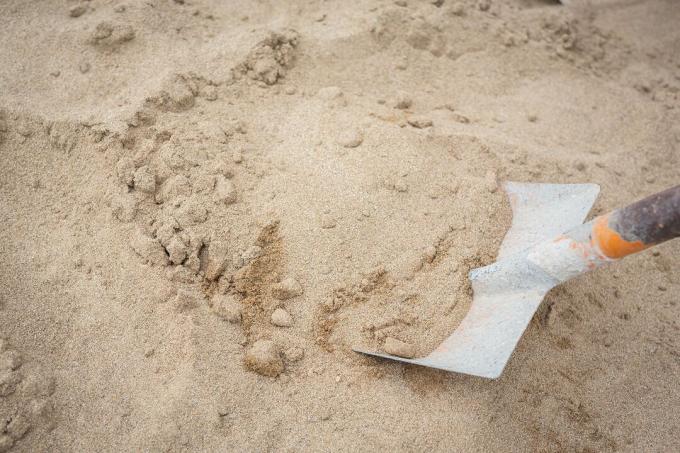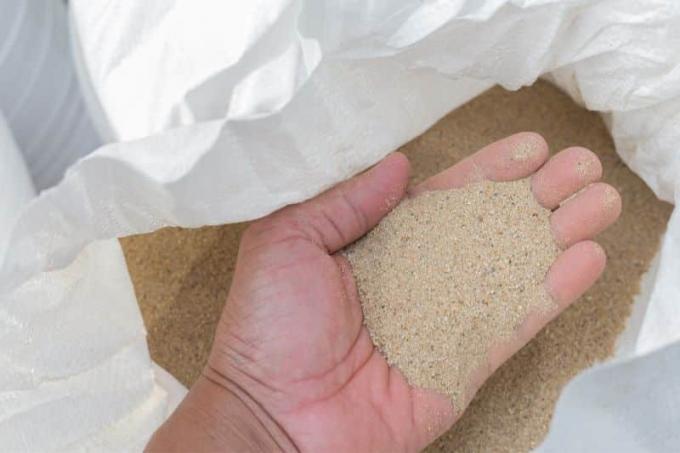
Lawn care is far from complete with mowing, fertilizing and watering. Regular sanding may also be necessary to counteract soil compaction. But not every sand such. B. Building sand or play sand brings the desired loosening up of the lawn.
In a nutshell
- Building sand & play sand can loosen up compacted lawns
- must be low in lime and free of clay and silt
- the grain size may only be 0-2 mm
- Apply a 2 mm thick layer in spring or autumn
- Mow the lawn beforehand, scarify and, if necessary, aerate
Table of contents
- Special lawn sand is not a must
- Building sand and play sand as a substitute
- Pay attention to fine grain
- Use clean sand
- old sand
- Preparations before sanding
- frequently asked Questions
Special lawn sand is not a must
Large sacks of special lawn sand are available from specialist retailers. This is usually clean, fine quartz sand. If you reach for it, you can be sure that it is optimally suited for the green area. But the larger the lawn, the more urgent the question of costs. Because this sand is expensive. The good news is: it is not without alternatives!

Building sand and play sand as a substitute
building sand and play sand are several times cheaper than special sand for the lawn. In fact, you can use both types of sand for sanding. But there can be differences in the composition and quality of both building sand and play sand. This is exactly what needs to be put to the test so that the desired effect is not absent or even reversed.
Pay attention to fine grain
Coarse-grain sand has difficulty penetrating compacted subsoil. Therefore, only building sand or sand should be used to sand a lawn. Play sand with the following characteristics can be used:
- very fine grain
- Values between 0.3 and a maximum of 2 mm are ideal
- preferably round-grained
Commercial play sand is usually fine-grained enough to serve as a lawn sand substitute. The grain size of construction sand can vary greatly.

Tip: The available building sand consists of different grain sizes? You may be able to sift through it and gain lawn sand.
Use clean sand
Building sand and play sand should be low in lime so that the soil pH is not changed unfavorably. In addition, it must not be interspersed with components that are not conducive to the objective of sanding. What is meant by this are above all clay and silt portions that tend to clump together. For this reason, only use clean, washed sand.
Tip: You can also wash smaller quantities of sand afterwards at home. This is not recommended for larger quantities. Drying is very cumbersome, takes up a lot of space and/or time. And wet sand is difficult to spread evenly.
old sand
You can use newly purchased play sand and building sand immediately for the sanding of the lawn use if they meet the eligibility criteria outlined above. If the sand has been in the sandpit for a long time or was left open on a construction site, the original condition can no longer be assumed. Thoroughly inspect old sand before use:
- old sand may be contaminated
- washing out is not always easy
- possibly. buy new sand
- use old sand for other things

Preparations before sanding
What applies to special lawn sand also applies to building sand and play sand. So that the fine grains can optimally loosen the soil, it must be properly prepared before sanding. The following steps should not be skipped, nor should they be carried out carelessly.
- Mow at a height of 3 centimeters
- verticulate, removal of thatch and moss
- aeration

Tip: Even if scarifying benefits the lawn in the long run, it is a strain on the grass at first. Strengthen it by using it two weeks before lawn fertilizer take care of.
frequently asked Questions
After the preparatory work steps, the sand is evenly distributed over the entire lawn surface. This works best with the back of a rake. The sand layer should be about one to two centimeters high. In any case, the tips of the grass still have to stick out. The lawn must then be thoroughly watered so that the water washes the sand into the fine scarifying indentations.
Almost every lawn should be sanded regularly and right from the start so that the soil does not become too compacted. The more loamy the subsoil is and the more the lawn is used, the more important it is to loosen it up with sand. Otherwise, poor grass growth as well as moss and weeds can be expected over time. Only lawns that have been sown on very sandy soil are less prone to compaction. Sanding can often be dispensed with here.
It is not a question of the type of sand, which amount has to be spread. It depends a lot on the condition of the lawn. of soil compaction. It can vary between 2 and 10 liters per square meter.
Spring is the best time to sand a lawn. And if possible every year! Alternatively, the sanding or a second round can also be carried out in autumn.
If the lawn already shows clear signs of compacted soil, even sanding cannot bring a quick recovery. If it is carried out at least once a year, a significant improvement in the lawn can be expected after about three years.
